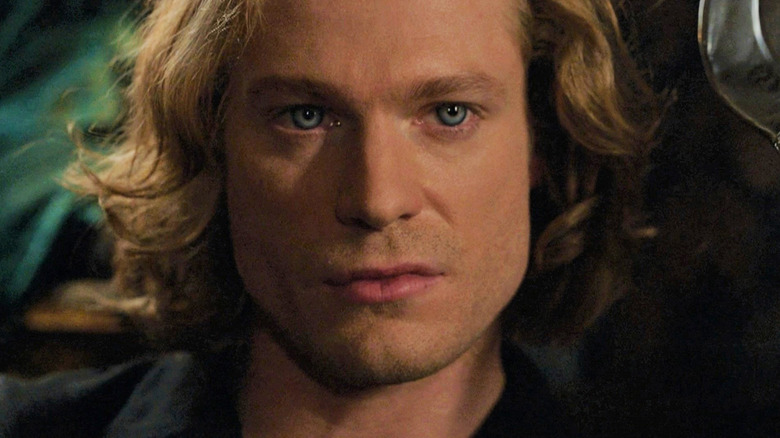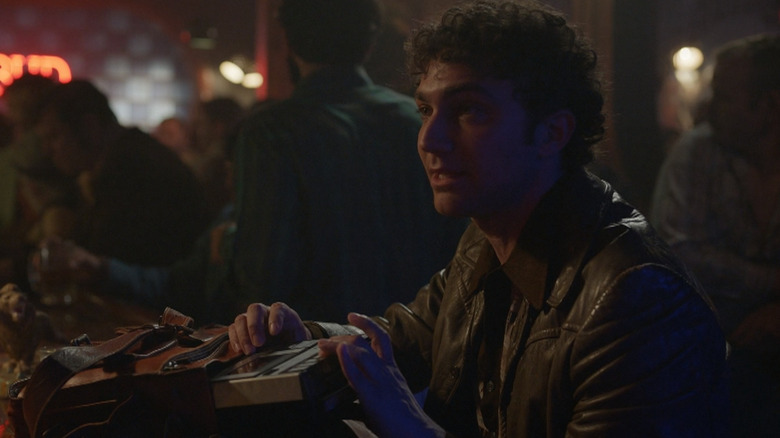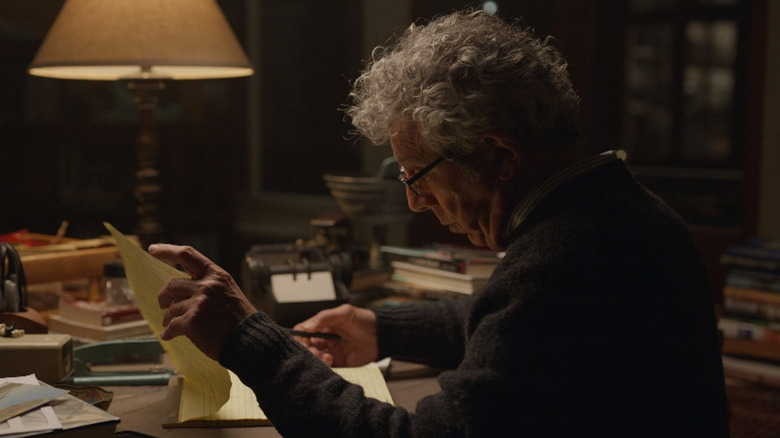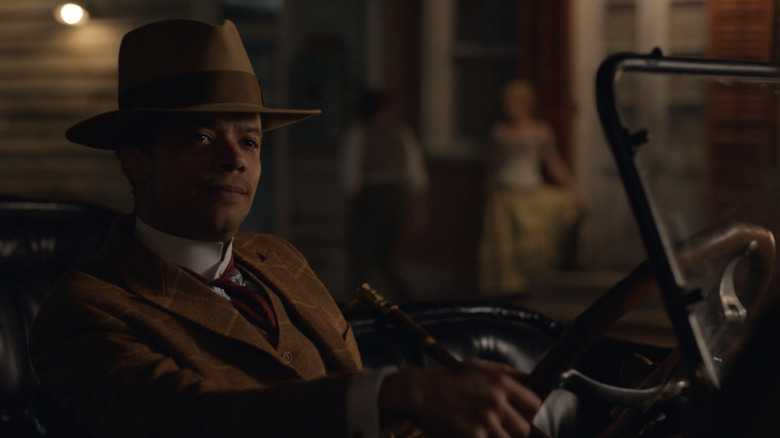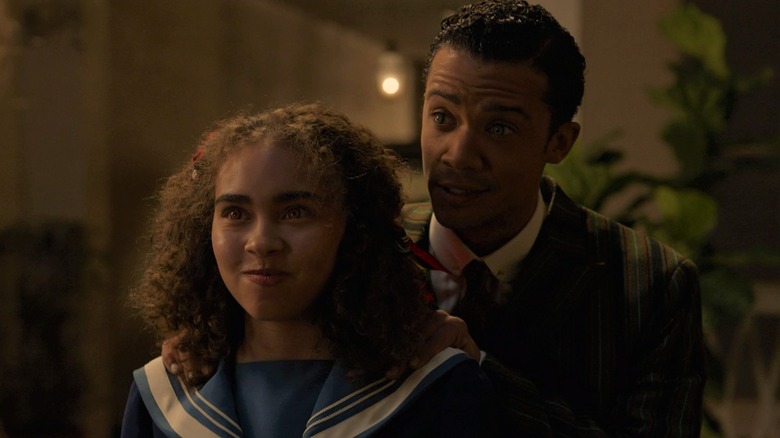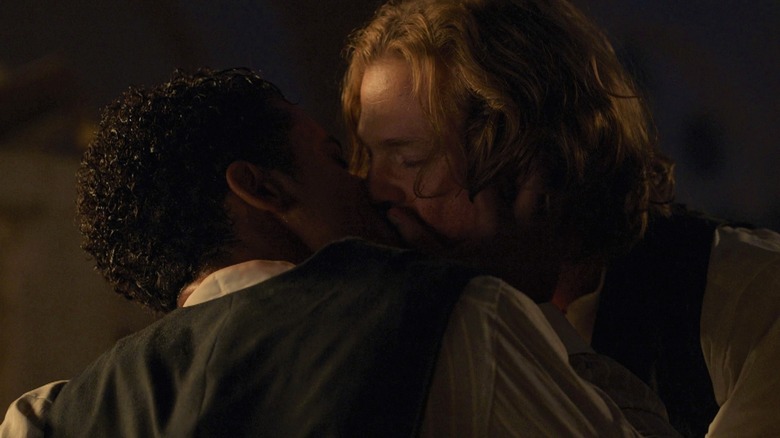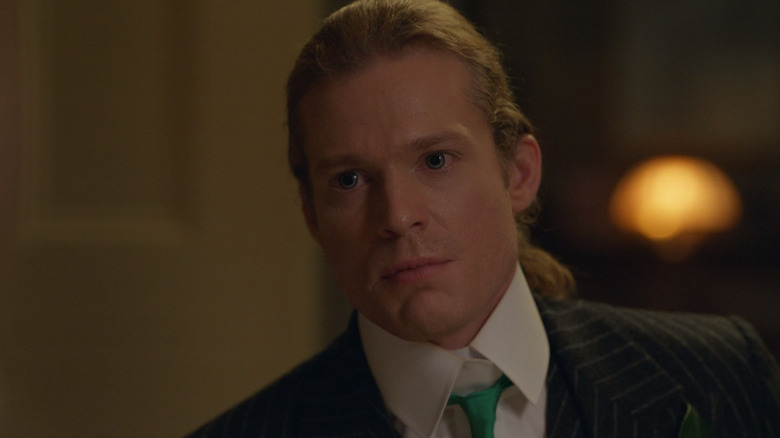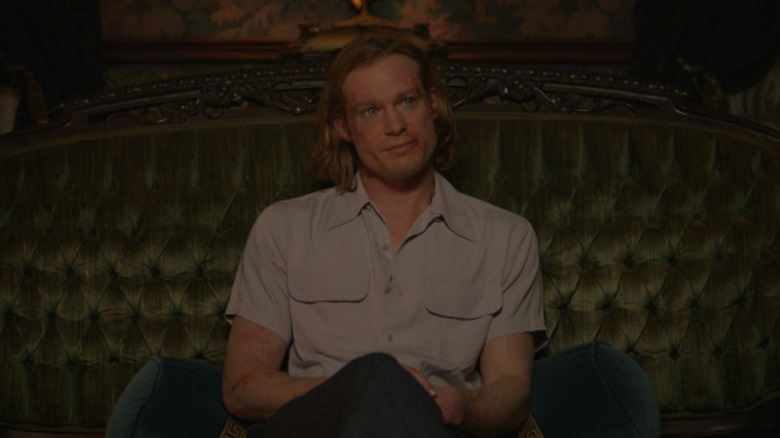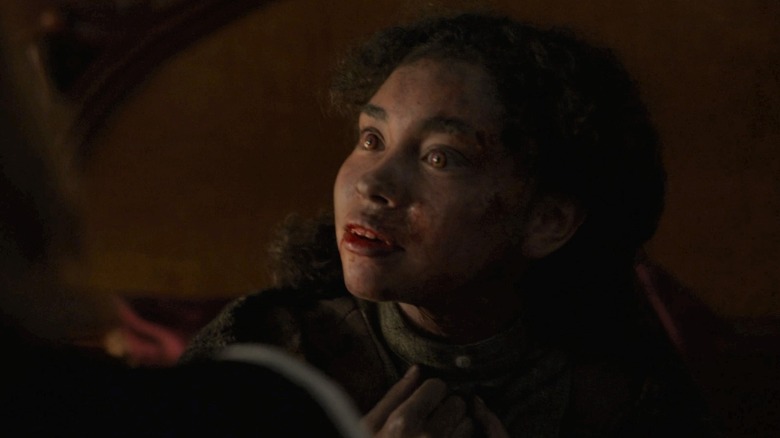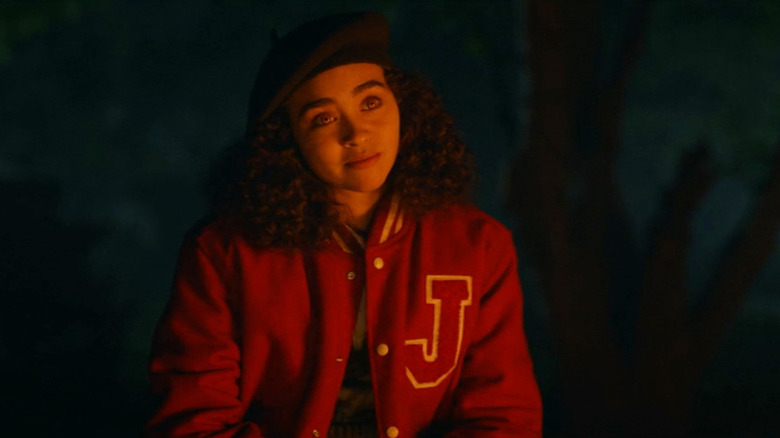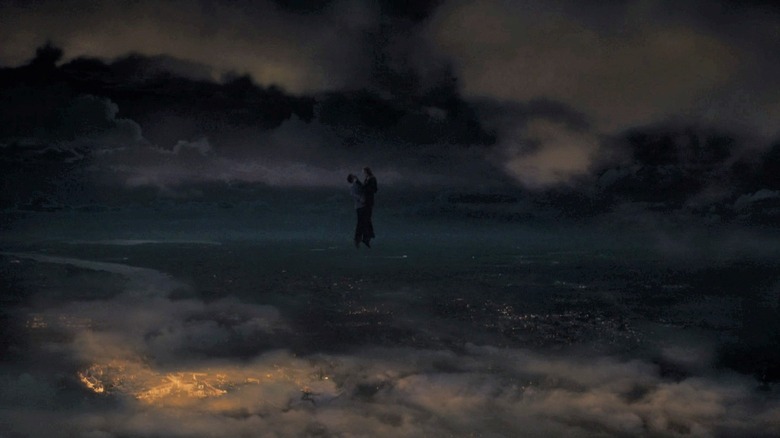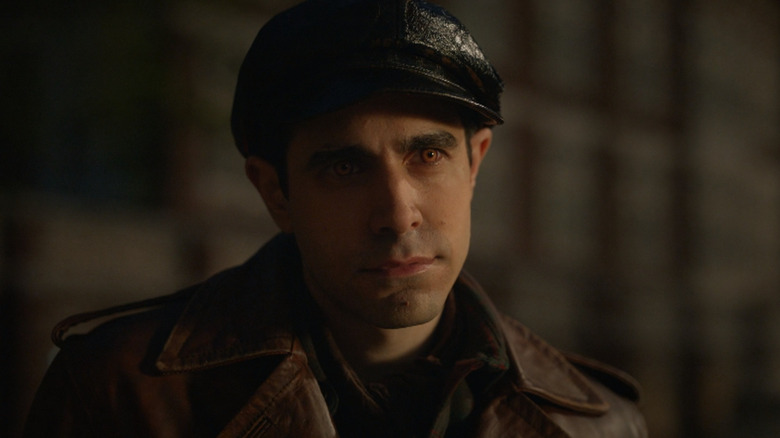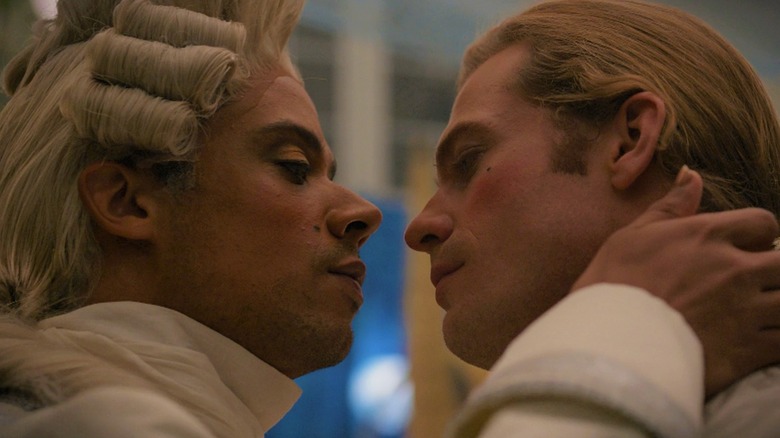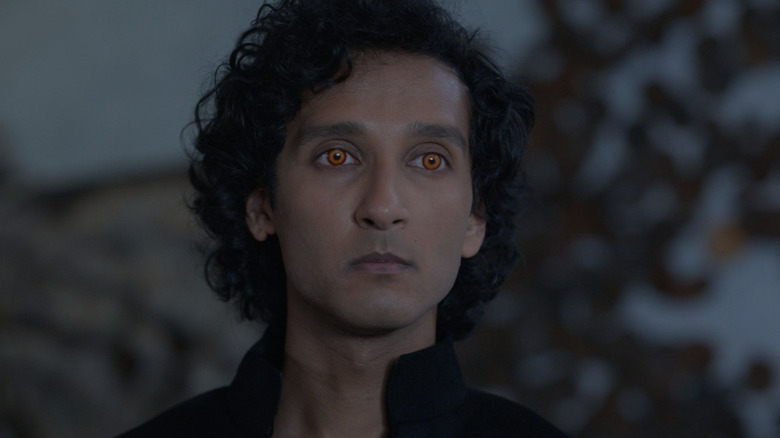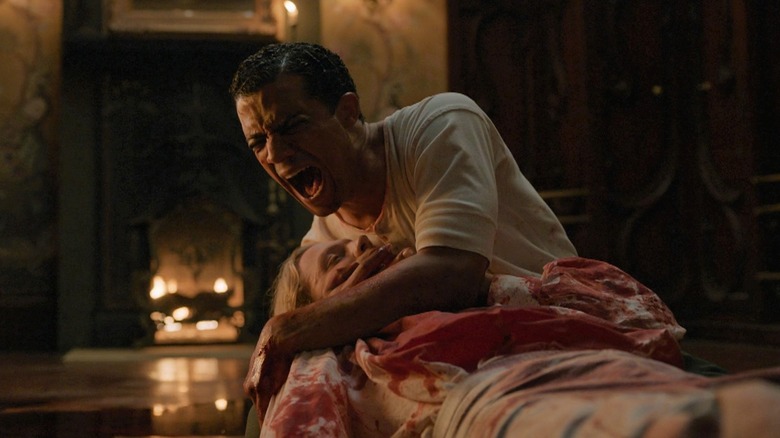The Biggest Differences Between The Interview With The Vampire Books And The Series
Based on the 1976 gothic horror novel by Anne Rice, AMC's "Interview with the Vampire" is the saga of immortal lovers Louis de Pointe du Lac (Jacob Anderson) and Lestat de Lioncourt (Sam Reid). In the present day, journalist Daniel Molloy (Eric Bogosian) interviews the vampiric Louis, gaining insight into his life in New Orleans at the turn of the 20th century, his seduction and turning at Lestat's hands, and their years raising the vampire child Claudia (Bailey Bass). Under Daniel's scrutiny, Louis is forced to confront his own devilish nature and make a shocking realization about his past.
"Interview with the Vampire" makes several changes to the source material and includes elements from later novels in Rice's long-running "Vampire Chronicles" series. In an interview with Den of Geek, show creator Rolin Jones acknowledged these differences, but also expressed his belief that fans will ultimately embrace the show's fealty to Rice's work. Indeed, while "Interview with the Vampire" is a largely faithful adaptation — every episode title, from "In Throes of Increasing Wonder" to "The Thing Lay Still," is taken from the book — it still takes plenty of creative liberties. We're here to examine some of the most major differences between Anne Rice's "Interview with the Vampire" novel and the AMC television series.
It's an adaptation and a sequel
One of the most ingenious aspects of AMC's "Interview with the Vampire" is that it's both an adaptation of Anne Rice's famous novel and a direct sequel. Taking place in then-contemporary 1970s San Francisco, the book begins with the journalist Daniel Molloy tape-recording his conversation with the vampire Louis de Pointe du Lac. Louis' entire life story unfolds in this single interview, which takes place over the course of one very long night. The "Interview with the Vampire" novel ends with Louis violently attacking Daniel (but ultimately sparing his life) after Daniel begs to be turned into a vampire.
Episode 1 of AMC's "Interview with the Vampire," "In Throes of Increasing Wonder," establishes that the 1973 San Francisco interview happened, but picks up almost 50 years later in 2022. Louis sends tapes of the original conversation to the much-older Daniel — who still bears the scars of Louis' assault — entreating him to meet in Dubai for a second interview.
This change is an olive branch to diehard fans of Rice's "Vampire Chronicles," acknowledging the original version of the story is still intact on the bookshelf. But it's also a bold move on the part of the show's creators. By making the series a sequel to the book, they're freed from the task of directly recreating it. The show revisits and recontextualizes key events from the novel, presenting a more nuanced portrait of the characters.
Daniel's life unfolds very differently
Of all the characters on "Interview with the Vampire," Daniel Molloy is one of the most drastically changed in the leap from page to screen. In the novel, he's a reporter known only as "the boy." The third book, "The Queen of the Damned," finds him 12 years later and reveals his name is Daniel Molloy. Daniel publishes "Interview with the Vampire" in-universe as a bestselling book, and becomes entangled with the vampire Armand. The two have an intense love affair, but Armand refuses to turn Daniel into a vampire, relenting only when Daniel is dying from the effects of alcoholism. Despite getting what he always wanted, Daniel's relationship with Armand remains turbulent for the rest of the series.
AMC's "Interview with the Vampire" goes in a different direction. Daniel survives his fateful 1973 interview but does not pursue vampires again until Louis contacts him in 2022. In the mean time, he becomes a Pulitzer Prize-winning reporter, grows estranged from his family, and begins living with Parkinson's disease. No longer the naïve boy of the book, Daniel is cynical and abrasive, but also a more active participant in the story. The season finale, "The Thing Lay Still," ends with Daniel face-to-face with Armand. Given their history in the novels, this sets up intriguing possibilities for Season 2.
If you or anyone you know needs help with addiction issues, help is available. Visit theSubstance Abuse and Mental Health Services Administration website or contact SAMHSA's National Helpline at 1-800-662-HELP (4357).
The story is updated to the 20th century
When fans of the "Vampire Chronicles" series saw the first trailer for the "Interview with the Vampire" television series, one significant change to the source material was immediately apparent: the time period. "It was 1910," Louis narrates over the footage, bringing the storyline of "Interview with the Vampire" over 100 years forward. In the novel, Louis is born in 1766, the eldest son of a French immigrant family that runs an indigo plantation in New Orleans. Though "Interview with the Vampire" features bloodthirsty monsters as the leads, vampires are fictional. Asking 2022 audiences to be sympathetic to a hero complicit in the horrors of slavery is a step too far.
"I didn't know how to tell the plantation owner story," Rolin Jones told Den of Geek, adding that moving the story to the early 20th century was a visual choice as well as a practical one. Louis' Season 1 story spans roughly 30 years, carrying the vampires through the Jazz Age and ending at the dawn of World War II. Louis is reimagined as a brothel owner in Storyville, New Orleans' red light district. Episode 3, "Is My Very Nature That of a Devil," takes inspiration from this era of Louisiana's history by incorporating the discriminatory Ordinance 4118 as a story element and featuring legendary jazz pianist Jelly Roll Morton (Kyle Roussel) in a cameo.
The series is more diverse
Anne Rice's immortal book has been on the shelves for decades. While it continues to enthrall readers, the first installment of the "Vampire Chronicles" saga centers primarily around white male characters. Departing from both the novel and the Neil Jordan film, AMC's "Interview with the Vampire" embraces the diverse reality of New Orleans in the early 20th century.
Depicted in the novels as white, Louis and Claudia (Bailey Bass) of the show are both Black Creole. Their experiences in the Jim Crow South are essential to the narrative and inform how they embrace their vampiric powers. As Jacob Anderson told The Washington Post, "Louis' race changes the trajectory slightly of that character." For example, as a vampire, Louis is empowered to kill the racist businessmen and politicians who aim to disenfranchise him.
"Interview with the Vampire" features a wide array of performers, from the series' leads to supporting characters like Bricktop Williams (Dana Gourrier) and Peg Leg Doris (Rachel Handler). Assad Zaman plays the vampire Armand, a major presence going forward, and Antoine, Lestat's musician lover and fledgling, is reimagined as Antoinette (Maura Grace Athari), a torch singer. The show's diverse casting adds another dimension to Rice's work by shining a spotlight on people not often represented in vampire fiction.
Vampires are sexually active
Same-sex desire has always been closely intertwined with vampire fiction, from the gothic heroine of Sheridan Le Fanu's 1872 horror novella "Carmilla" to the pansexual bloodsuckers of FX's "What We Do in The Shadows." Part of the reason Anne Rice's "Vampire Chronicles" developed a devoted cult following is its complex depiction of LGBTQ characters, with Rice herself confirming in a 2015 Facebook post that beguiling antihero Lestat is bisexual.
Louis and Lestat are openly depicted as a romantic couple in later books, such as 1988's "The Queen of the Damned," but that part of their relationship is mostly subtextual in "Interview with the Vampire." Eagle-eyed readers can pick up on the significance of Lestat and Louis being parents to Claudia, but there's one major complication: Vampires can't have sex.
In Anne Rice's mythology, when a person dies and becomes a vampire, the transformation renders them unable to have physical intercourse, though shared blood-drinking operates as an intimate act. The "Interview with the Vampire" TV adaptation omits this limitation completely, with Season 1 containing multiple sex scenes between vampires and their partners. These added scenes are far from gratuitous; rather, they bring the book's LGBTQ themes out of the shadows and into the light. Lestat's dark seduction of Louis is as literal now as it is metaphorical, and an essential step in Louis embracing himself as a gay man.
Major book characters are cut
When adapting a centuries-spanning novel that finishes at over 300 pages, it's inevitable that some characters and events will end up on the cutting room floor. When Lestat first turns Louis and moves onto his indigo plantation in the "Interview with the Vampire" novel, he resentfully brings his elderly human father with him. During a slave uprising, Louis mercy-kills Lestat's father, but not before demanding that Lestat make begrudging peace with the old man. The AMC series' timeline shift to 1910 means that Lestat's father is dead. After revealing how his father mistreated him in his youth, Lestat confesses that he inherited his temper, foreshadowing the tragic relationship between Lestat and Claudia.
Also absent is Babette Freniere. In the book, Louis becomes enamored of Babette, and, after Lestat's murder of her brother, encourages her to manage her family's plantation, despite the era's deeply ingrained sexism. Babette is initially successful, but is horrified to learn that her mysterious benefactor is a vampire. Mentally tormented, she becomes a shadow of herself. Babette is a cautionary tale for Louis, driving him further away from human connections. But the shifting timeline, as well as a greater focus on Louis' relationship with his sister Grace, likely made Babette redundant in the TV series.
Lestat's past is revealed
The Lestat de Lioncourt who appears in Anne Rice's "Interview with the Vampire" is a mystery. Cruel and vain, he serves mostly as an antagonist to Louis and Claudia. Lestat remains tight-lipped about his origins, unwilling to relinquish any knowledge of where vampires come from or why they exist. This refusal breeds resentment in his fledglings, and is one of the reasons why Claudia conspires to kill him.
"The Vampire Lestat," the 1985 sequel to "Interview with the Vampire," reframes Lestat as the protagonist of the "Vampire Chronicles" and Anne Rice's beloved "brat prince." The show draws on that book's characterization of Lestat, making him a more romantic figure who is open about his past. In Episode 1, he confides to Louis' family about how his father pulled him out of the monastery as a boy, killing his faith. Episode 6, "Like Angels Put in Hell by God," features Lestat's pained explanation of how he was turned into a vampire against his will by his sire Magnus, who then abandoned him.
Lestat also alludes to characters introduced in "The Vampire Lestat." Specifically, he mentions his mother, and later plays a song he wrote for a young violinist. Lestat turns his mother, the enigmatic Gabrielle de Lioncourt, into a vampire and his infrequent traveling companion. The violinist, Nicolas de Lenfent, is Lestat's childhood friend and first love. More than just Easter eggs for fans, Gabrielle and Nicolas could prove to be important characters in future seasons.
Claudia's new origin
"Claudia, for me, personally, is [Anne Rice's] greatest creation," "Interview with the Vampire" creator Rolin Jones told Den of Geek. But the character has proved thorny for live-action adaptations. Turned at the age of five, Claudia's consciousness matures even though her body doesn't, which is a source of unending torment to her. In the 1994 film, Claudia is played by a young Kirsten Dunst. But the series goes farther by aging Claudia into an eternal teenager, portrayed by Bailey Bass. While child labor laws were an admitted factor in this casting, as Jones revealed to Syfy, this change opened the door for the show to reimagine Claudia's origin.
The novel introduces Claudia as an orphan who's found crying over her mother's plague-stricken corpse. In a moment of weakness, Louis bites and drains the girl; Lestat turns her into a vampire to manipulate the guilt-ridden Louis into staying with him. Episodes 3 and 4 dramatically change her story, and her dynamic with Lestat and Louis. When white mobs raze Storyville, Louis rescues Claudia from a burning boarding house. Bringing her back to their shared home, Louis begs Lestat to turn the badly-burned girl into a vampire and promises that she will be a daughter to them both. The change makes Louis and Lestat more sympathetic, while keeping them responsible for her fate. Claudia being a teenager also allows the TV series to explore storylines that would not be possible in the novel.
Claudia is older, but not necessarily wiser
Claudia is one of the most tragic characters in the "Vampire Chronicles." But being 14 forever, rather than eternally five, gives the TV Claudia more freedom. The novel's Claudia depends on Louis and Lestat because her small size makes it impossible for her to live alone. TV Claudia is granted more independence, explores the world outside New Orleans, and even narrates multiple episodes through her diary excerpts.
Claudia falls in love with a man named Charlie in Episode 4, "The Ruthless Pursuit of Blood with All a Child's Demanding." In a moment of passion, Claudia accidentally kills him. Lestat forces her to watch him burn Charlie's corpse in the incinerator as a lesson in getting too close to humans. This cruel moment has consequences that play out in Episode 5, "A Vile Hunger for Your Hammering Heart." Claudia indulges in a secret murder spree, taking trophies from the bodies and nearly exposing the vampires to the police. She then sets out on her own, posing as a university student, and encounters another vampire who is strongly implied to sexually assault her. AMC's Claudia has more agency, but even with all the powers of a vampire, she still finds the world a harsh and uncaring place.
If you or anyone you know has been a victim of sexual assault, help is available. Visit the Rape, Abuse & Incest National Network website or contact RAINN's National Helpline at 1-800-656-HOPE (4673).
Louis and Lestat's fight is a darker take on a later book scene
"Interview with the Vampire" fans will likely never forget the shocking conclusion to "A Vile Hunger for Your Hammering Heart." Now living in seclusion without Claudia, Louis' depression, as well as Lestat's ongoing affair with Antoinette, drives a wedge between the pair. When Claudia returns and asks Louis to leave with her, the scene erupts into violence.
Lestat attacks Louis with the full force of his vampiric strength, demolishing their house around them. He then reveals to Louis that he has the "Cloud Gift" — the power to fly — by carrying Louis hundreds of feet into the air. When Louis begs Lestat to let him go, Lestat takes him at his word: He drops and nearly kills him.
This disturbing scene was created for the TV series; despite Louis and Lestat's tempestuous relationship in the first novel, it never reaches this level of violence. However, the show possibly takes inspiration from a late scene in "The Queen of the Damned," where Lestat reveals his Cloud Gift in a much more romantic context by taking Louis flying with him. By putting a dark spin on this scene, the AMC series shows just how twisted and toxic their romance has become.
If you or someone you know is dealing with domestic abuse, you can call the National Domestic Violence Hotline at 1−800−799−7233. You can also find more information, resources, and support at their website.
The show includes surprise cameos
Anne Rice's "Interview with the Vampire" introduces only a handful of the dozens of blood-drinkers who populate the "Vampire Chronicles." Spanning 13 books, the series ends with 2018's "Blood Communion: A Tale of Prince Lestat," Rice's final book before her death in 2021. AMC's series draws upon this rich history, introducing characters in what are essentially extended cameos and Easter eggs for fans.
"A Vile Hunger for Your Hammering Heart" features Bruce (Damon Daunno), a vampire biker who encounters Claudia while she poses as a university student. Together, they kill a racist student who harassed Claudia. She suggests that "Killer" would be a more fitting name for Bruce, and they talk about forming a "fang gang" of vampires before he turns on her. On the page, Killer appears in 1988's "The Queen of the Damned" as the leader of the Fang Gang, rebellious young vamps who are violently dispatched by Queen Akasha.
The show reaches even deeper into "Vampire Chronicles" lore in "Like Angels Put in Hell by God" when Dr. Fareed Bhansali (Gopal Divan) administers medical care to Daniel. Though he appears human on the show, Fareed is a vampire who debuts in 2014's "Prince Lestat." There, Fareed uses his scientific genius to experiment on vampires, resulting in the birth of Lestat's biological son, Viktor. This event could be a fascinating plot development in a future season.
Lestat's death is now a party to die for
Lestat being Lestat, his death can be nothing less than spectacular. Taking place approximately halfway through the book, Louis and Claudia's attempted murder of their maker is dramatically heightened in the "Interview with the Vampire" season finale. In Rice's version, Claudia plots to poison Lestat by tricking him into drinking the dead blood of twin boys drugged with absinthe and laudanum. Despite Louis' pleas, Claudia slits Lestat's throat. They dispose of his body, but permanently killing a vampire is more difficult than they anticipated.
The series' murder plot is a much more elaborate affair that unfolds during a Mardi Gras masquerade. In "The Thing Lay Still," Claudia and Louis are co-conspirators, though Louis still feels the pull of his bond with Lestat. Louis distracts Lestat with a scandalous romantic waltz before their final feast. The two are dressed as 18th century nobility, a nod to the book's original setting. Luring unsuspecting guests to their home with the promise of sharing their secret to eternal life, the three vampires kill them. Lestat, aided by his fledgling Antoinette, anticipates the trap with the twins, but Claudia tricks him into drinking the poisoned blood of a man who slighted him earlier.
In the show, Louis is the one who finishes Lestat by cutting his throat with the sword cane that initially drew Lestat to him. The sequence is a grisly, baroque masterpiece — and the ultimate break-up.
Rashid is a new ruse
The "Interview with the Vampire" season finale, "The Thing Lay Still," ends with a shocking cliffhanger: Louis' servant Rashid is revealed to be the ancient vampire Armand. But who are Rashid and Armand? This elaborate ruse is wholly original to the television series.
Rashid is introduced as Louis' personal assistant in Dubai. A quiet but forceful presence, Rashid is dedicated to his employer and springs to his defense against Daniel's journalistic probing. While Rashid appears to be human — at several points walking in direct sunlight — Daniel becomes suspicious. A dream about his first meeting with Louis stirs Daniel's memories, and he recalls that Rashid was Louis' companion 50 years earlier. Rashid reveals himself to be a 514-year-old vampire whose strength and age make him immune to sunlight. Louis introduces him as his lover Armand.
Portrayed by Antonio Banderas in the 1994 film, Armand is a deceptively youthful-looking vampire with a dark, obsessive personality. Armand runs the Théâtre des Vampires, which was inspired by longtime rival Lestat, and becomes — for a time — Louis' lover and companion. Season 1 of "Interview with the Vampire" ends before explaining the purpose of Armand's deception. The elder vampire originally appears in the second half of the novel, where he meets Louis and Claudia in Paris, so his presence at the very beginning of the series is itself a major departure.
The series is about the odyssey of recollection
Can a vampire be trusted to tell the truth? Or is memory itself the monster? "Interview with the Vampire" positions Louis as an unreliable narrator; despite his supernatural gifts, his memory is fallible. After decades of death and trauma, what Louis tells Daniel during their interview may not necessarily be what happened, or even what Louis thinks happened. The "odyssey of recollection," a phrase taken from a line in Daniel's memoir, is a powerful theme introduced in the show.
In Anne Rice's "Interview with the Vampire," Louis' story is presented as a long confession of guilt with near-religious overtones. Though Lestat raises objections about Louis' story in his self-titled sequel novel — possibly making him an unreliable narrator — the show brings unique focus to the idea. Daniel challenges Louis over his inconsistencies in their recordings, asking questions when they seem performative or rehearsed. When Daniel is gifted Claudia's diaries, pages have been removed in what could be seen as Louis' editorializing — or his censorship — of her life story.
The psychological dam breaks in the Season 1 finale. Daniel accuses Louis of saving Lestat's life, effectively choosing him over Claudia. Louis appears to face painful memories of Lestat he'd locked away. The fact that Daniel himself seems to be recovering forgotten memories of his first encounter with the vampires adds another curious wrinkle. If one thing's clear, it's that the odyssey of recollection in "Interview with the Vampire" is far from over.
